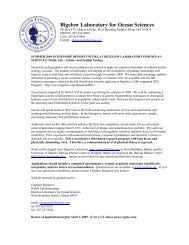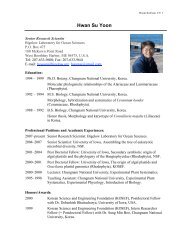Mapping the Depth.pdf - Bigelow Laboratory for Ocean Sciences
Mapping the Depth.pdf - Bigelow Laboratory for Ocean Sciences
Mapping the Depth.pdf - Bigelow Laboratory for Ocean Sciences
You also want an ePaper? Increase the reach of your titles
YUMPU automatically turns print PDFs into web optimized ePapers that Google loves.
MAPPING THE DEPTH & POPULATION OF A TIDEPOOL<br />
Subject: Tidepool Ecology<br />
Grade Level: 9-12 (could be adapted <strong>for</strong> 5-8)<br />
Time Required: 1 classroom period, 1 field<br />
trip day<br />
Maine Learning Results Standards:<br />
Science and Technology: B3, B4, J1-3, K1-6<br />
Ma<strong>the</strong>matics: C1-4, F1<br />
Student Learning Objectives<br />
1. Collaborate with o<strong>the</strong>r members of a team.<br />
2. Research relevant in<strong>for</strong>mation which relates to a specified tidepool species.<br />
3. Collect data via a virtual tidepool sampling experience.<br />
4. Record and interpret ga<strong>the</strong>red in<strong>for</strong>mati,on.<br />
5. Contribute to <strong>the</strong> completion of a scientific report and class conference.<br />
Background<br />
One of <strong>the</strong> most well-known "by-products" of tides are tidepools. Tidepools are small pools<br />
maintained by water brought in and flushed out by tides. A wide range of life <strong>for</strong>ms can be found<br />
in tidal pool communities. The fauna and flora of tidepools must adapt to constant environmental<br />
changes caused by <strong>the</strong> incoming and outgoing tides. The location of an organism relative to <strong>the</strong><br />
tide level significantly affects <strong>the</strong> physical conditions it faces. So, tide pool residents must be able<br />
to cope with a highly variable environment. Organisms that live near <strong>the</strong> top of <strong>the</strong> high tide line<br />
are submerged in water only occasionally. Organisms that live near <strong>the</strong> low tide line are almost<br />
always under water. Many tidepool plants and animals attach <strong>the</strong>mselves to hard, rocky outcrops<br />
and are capable of remaining anchored against <strong>the</strong> intense action of winds and waves. At low<br />
tide, tidepool organisms are often exposed to extreme temperatures, harsh winds, and direct<br />
sunlight. In general, tidepool organisms must <strong>the</strong>re<strong>for</strong>e be fairly robust creatures in order to<br />
survive.<br />
Materials<br />
• tidepool area<br />
• 2 pieces of fishing line or twine, each 2 meters long<br />
• lead fishing weight or metal washer<br />
• meter stick<br />
• field journal<br />
• graph paper<br />
• field guide or organism identifier<br />
Field Trip – Transect Activity<br />
• Investigate an area with many tidepools. Split <strong>the</strong> class into groups.<br />
• Locate a number of tidepools with varying depth (i.e., bottoms should not be flat).
For each tidepool, THE FIRST HALF OF THE GROUP should:<br />
1. Make a depth gauge by tying <strong>the</strong> weight or washer to one piece of <strong>the</strong> fishing line. This<br />
tool will be used to find <strong>the</strong> depth of various locations in <strong>the</strong> tidepool. Do not use <strong>the</strong> meter<br />
stick in <strong>the</strong> salt water. The paint will discolor or come off completely.<br />
2. Use a felt pen and divide <strong>the</strong> o<strong>the</strong>r piece of fishing line into 20 cm sections.<br />
3. Stretch <strong>the</strong> marked fishing line from one side of <strong>the</strong> tidepool to <strong>the</strong> o<strong>the</strong>r (to get <strong>the</strong><br />
tidepool's length; see diagram below). This "guide line" across <strong>the</strong> tidepool is called a<br />
"transect."<br />
4. Using <strong>the</strong> weighted line, carefully drop <strong>the</strong> sink into <strong>the</strong> water at <strong>the</strong> first mark. This will<br />
be station "A". Allow <strong>the</strong> sink to touch <strong>the</strong> bottom of <strong>the</strong> pool. Pull <strong>the</strong> line until it is taut.<br />
Make sure that <strong>the</strong> sink is still touching <strong>the</strong> bottom.<br />
5. Hold <strong>the</strong> line at <strong>the</strong> surface of <strong>the</strong> water and pull it out of <strong>the</strong> water. Be sure not to move<br />
your fingers.<br />
6. Use <strong>the</strong> meter stick to measure <strong>the</strong> distance from <strong>the</strong> bottom of <strong>the</strong> sinker to <strong>the</strong> surface<br />
marking.<br />
7. Record <strong>the</strong> depth (cm) of station "A" in <strong>the</strong> field journal.<br />
8. Repeat steps 4 through 7 <strong>for</strong> each of <strong>the</strong> markings. Call <strong>the</strong> subsequent stations "B," "C,"<br />
and so on.<br />
9. Once you have recorded <strong>the</strong> depth <strong>for</strong> all of <strong>the</strong> markings across <strong>the</strong> tidepool, repeat <strong>the</strong><br />
same <strong>for</strong> <strong>the</strong> width of <strong>the</strong> tidepool.<br />
10. Use <strong>the</strong> graph paper to construct a depth chart. (Refer to sample chart)<br />
11. If <strong>the</strong> tidepool is relatively wide, you can make additional transects. Be careful to use<br />
different station labels <strong>for</strong> each transect.<br />
For <strong>the</strong> same tidepool, THE SECOND HALF OF THE GROUP should:<br />
1. Identify and list as many organisms as possible. You can use your field guide to identify<br />
tidepool organisms. [CAUTION: Your tidepool's organisms may or may not be <strong>the</strong> same!]<br />
2. Using graph paper, draw <strong>the</strong> location of <strong>the</strong> organisms using <strong>the</strong> station labels that were<br />
chosen by <strong>the</strong> first half of <strong>the</strong> group.<br />
3. After <strong>the</strong> field trip, use <strong>the</strong> field notes to determine <strong>the</strong> population of each organism and<br />
<strong>the</strong>ir location within <strong>the</strong> tidepool.<br />
4. Construct a "pie chart" of <strong>the</strong> populations <strong>for</strong> each type of organism. Which had <strong>the</strong><br />
greatest population? Did <strong>the</strong> organisms' locations correspond to certain depths within <strong>the</strong><br />
tidepool?<br />
Example of one depth<br />
transect across <strong>the</strong><br />
length of a tidepool.<br />
Stations are separated<br />
by 20 centimeters and<br />
labelled "A" through<br />
"G."
Ecosystem Etiquette<br />
Students should be dressed appropriately <strong>for</strong> <strong>the</strong> conditions. They should NEVER work with<br />
<strong>the</strong>ir backs to <strong>the</strong> water in <strong>the</strong> lower intertidal, keeping waves in view. All organisms should be<br />
returned to <strong>the</strong> location where <strong>the</strong>y were found. All disturbed rock, seaweed or o<strong>the</strong>r substrate<br />
should be returned to its original position. Animals should be treated with respect and care.<br />
Carry in, carry out and make every ef<strong>for</strong>t to leave no trace!<br />
CROSS-CURRICULAR IDEAS<br />
• Chemistry: What is <strong>the</strong> relationship to <strong>the</strong> depth of <strong>the</strong> tidepool and <strong>the</strong> salinity of <strong>the</strong> water?<br />
• Physics/Ma<strong>the</strong>matics: What is <strong>the</strong> relationship between <strong>the</strong> depth of <strong>the</strong> tidepool and <strong>the</strong><br />
amount of water found in <strong>the</strong> pool? Take temperature reading at various depths and graph<br />
temperature versus depth.<br />
• English/Language Arts: There are many different life <strong>for</strong>ms in tidepools. Pick one and write<br />
a “day in <strong>the</strong> life of” story.<br />
• Ma<strong>the</strong>matics: Using data collected in <strong>the</strong> field, have <strong>the</strong> students create a class summation of<br />
<strong>the</strong> size of <strong>the</strong> tidepools studied and number of species found. Create a class graph. Is <strong>the</strong>re<br />
any relation between <strong>the</strong> size and <strong>the</strong> number of species? What about <strong>the</strong> size and o<strong>the</strong>r<br />
variables such as temperature or salinity?<br />
• Social <strong>Sciences</strong>: What is <strong>the</strong> impact of human activity on tidepool areas?<br />
• Physics/Ma<strong>the</strong>matics/Biology: How much <strong>for</strong>ce does a wave have? How do biological<br />
organisms survive in areas of strong wave action?<br />
Assessment<br />
Have students use cameras and camcorders to record <strong>the</strong> tide pools. Back in <strong>the</strong> class room, have<br />
students use <strong>the</strong>ir journal, along with <strong>the</strong> images, to construct a visual map and identification of<br />
species found. Hold a scientific conference on tidepools, where students discuss <strong>the</strong>ir<br />
observations, as a group analyze <strong>the</strong> data ga<strong>the</strong>red, generate questions unanswered by <strong>the</strong>ir data,<br />
and propose next steps in <strong>the</strong>ir investigation.<br />
Vocabulary<br />
<strong>Depth</strong> gauge: a device to measure depth.<br />
Fauna: is <strong>the</strong> representative animal or o<strong>the</strong>r life of a specific region. Fauna can also be<br />
representative of a particular time because of changing wea<strong>the</strong>r and climate conditions.<br />
Flora: is <strong>the</strong> representative plant-life of a specific region. Flora can also be representative of a<br />
particular time because of changing wea<strong>the</strong>r and climate conditions.<br />
Tidepool: a tidepool is usually found along a rocky coastal region. During high tide, water covers<br />
a good portion of <strong>the</strong> coast. During low tide, <strong>the</strong> water retreats to <strong>the</strong> sea. Tidepool are small<br />
pools of water hidden between <strong>the</strong> rocks left by <strong>the</strong> flowing tides. Tidepools serve as a refuge<br />
<strong>for</strong> marine animals during low tide.<br />
Adapted from "Winds of Change" educational CD-ROM, Copyright Caltech and NASA/Jet Propulsion <strong>Laboratory</strong>






